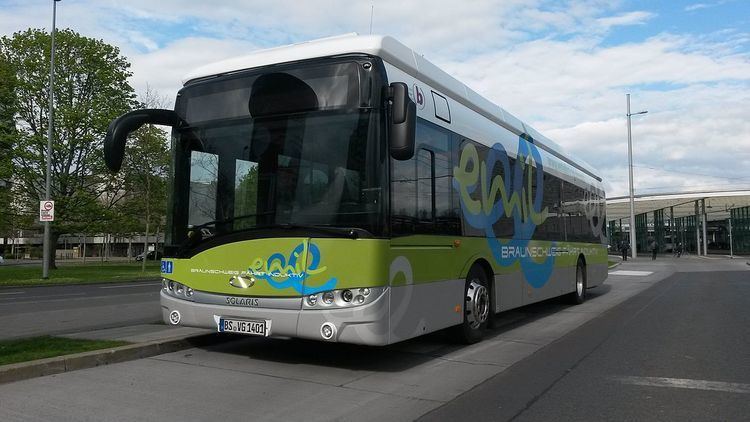A battery electric bus is a bus that is driven by an electric motor and obtains energy from an on-board battery. Many trolleybuses use batteries as an auxiliary or emergency power source.
Partial battery buses are equipped for charging with pantographs at bus stops and in the Depot. Supercapacitors can be charged rapidly, reducing the time needed to prepare to resume operation.
Battery electric buses offer the zero-emission, quiet operation and better acceleration compared to traditional buses. They also eliminate infrastructure needed for a constant grid connection and allow routes to be modified without infrastructure changes compared to a Trolleybus. They typically recover braking energy to increase efficiency by a regenerative brake. With energy consumption of about 1.2 kWh/km, the cost of ownership is lower than diesel buses.
As of 2016 battery buses have less range, higher weight, higher procurement costs. The reduced infrastructure for overhead lines is partially offset by the costs of the infrastructure to recharge the batteries. Battery buses are used almost exclusively in urban areas rather than for long-haul transport. Urban transit features relatively short intervals between charging opportunities. Sufficient recharging can take place within 4 to 5 minutes (250 to 450 kW) usually by induction or catenary.
The first battery buses were mostly small, mini- or midi- buses. The improvement of battery technology from around 2010 led to the emergence of the battery bus, including heavier units such as twelve-meter standard buses and articulated wagons.
In Shanghai catenary bus lines began switching to battery buses since 2009.In September 2010, Chinese automobile company BYD Auto began manufacturing the BYD K9.In 2011 bus manufacturer Contrac Cobus Industries from Wiesbaden announced the Cobus 2500e.In autumn 2012, Czech manufacturer Inmod supplied a LiFePo-powered SOR type EBN 8 to Mecklenburg-Vorpommern, Germany. The eight-meter-long vehicle has 22 seats, 35 standing places and a range of 160-170 kilometers a day, up to 220-260 km can be extended. The bus is recharged with a quick charger twice a day for one hour. Its maximum speed is 80 km/h.Beginning in 2012 run the Wiener Linien on bus routes 2A and 3A used electric buses. They are charged to the end user via a pantograph, which is applied to short catenary pieces. These are fed by the tram catenary. The cars have a range of around 150 kilometers.In May 2013 a battery bus began running between the airport and Palexpo in Geneva, Switzerland. This bus can be partially charged within 15 seconds. At the end of the line the charging process takes three to four minutes. The project cost five million francs.The Regional Transport Ruhr-Lippe GmbH (RLG) (Germany) began operating an electric minibus as a Quartierbus in May 2013. Vehicle range is approximately 120 kilometers. Recharging takes about three hours when fully discharged. Recharging consumes over 1.5 hours during the lunch break.The largest battery bus fleet is in Dalian, China. It includes 600 BYD buses. The purchase of a further 600 vehicles was planned for 2015.In 2013 battery buses entered service in the Netherlands.In Germany in 2013 battery buses were undergoing tests in Bremen and in Bonn.In 2015 BYD Auto planned to launch the first battery-double-decker bus.In Braunschweig battery buses entered regular service at the end of 2013. The "Emil" (Electromobility means of inductive load) project uses inductive charging. Both vehicles and charging stations were developed with Bombardier.In Gumi, South Korea in 2013 a road section was adapted to allow inductive charging while driving. The technology was tobe tested with two electric buses.In California, battery school buses since the end of October 2013 because of significantly lower operating costs, are used.In Hamburg Rampini battery buses entered service in 2014 on line 48.Dresdner Verkehrsbetriebe together with the Fraunhofer Institute for Transportation and Infrastructure Systems began testing battery buses in November 3, 2014. On June 17, 2015 passenger service began on the first route in Saxony. A four-minute stop at the last stop provides sufficient charge, with a high-power charger to preheat the passenger compartment.The Munich public transport company began testing battery buses in 2008. Experiments with Ebusco vehicles of were expected to reach a range of 300 km using lithium iron phosphate batteries.In Pinneberg testing began in 2014.In September 2015 four battery buses entered service in Berlin. The Solaris Urbino 12 charge by induction at the last stop.In July 2015 the Schleswig-Holstein Rendsburg purchased a Sileo battery bus with a range of 200 km for 450,000 euros. The bus does not charge during operation and can be operated for half a day. The bus is charged from a rooftop photovoltaic system.In Bonn test entered regular service in 2013. The range is at least 200 km.Botosani, Romania planned for public transport to operate fully electrically. at a conversion cost of 20 million euros.In October 2015 the double-decker buses were converted to BYD electrics with a range of 250 km. London's center-city access toll is waived for battery buses.As of 2015, BYD had sold about 6,000 of its buses worldwide. BYD is the world leader in the sale of electric vehicles.The California Department of Transportation contracted with Antelope Valley Transit Authority (AVTA) to switch its buses to 85 BYD battery buses with a range of at least 160 miles. Models include a 40 foot low-floor transit bus, a 60-foot low-floor articulated and a 45 foot commuter bus. Savings were expected to be $ 46,000 (41,300 euros) per bus per year.
